适用于滚轮式脚踏式液压升降平台车设计毕业设计答辩模板
- 格式:pptx
- 大小:281.98 KB
- 文档页数:25

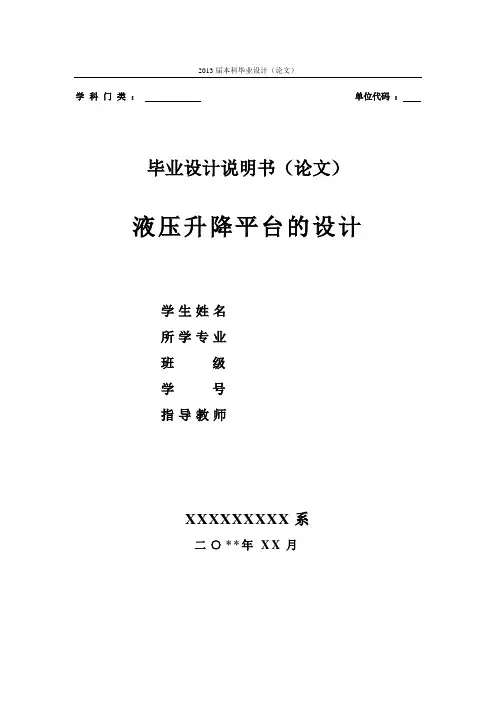
学科门类:单位代码:毕业设计说明书(论文)液压升降平台的设计学生姓名所学专业班级学号指导教师XXXXXXXXX系二○**年X X月摘要本次毕业设计对象是液压升降平台,这套装置主要用于举升重物。
它的举升高度为1米,举升重量为1吨,其动作主要是由两个双作用液压缸推动“X”型架,带动上板来实现的。
该液压升降平台主要由两个部分组成:机械部分和液压部分,其中机械部分主要由上板架、下板架、内连杆和外连杆四部分组成。
本设计设计、选择了机械部分材料与结构,并对其进行受理分析与校核,以便检验是否满足强度、刚度的要求,分析及校核的结果证明机械结构的设计可以满足要求。
在对液压控制系统的设计过程中,先进行了总体方案设计。
在选择液压的各个控制回路的时候,在对各个回路进行了对比后调速回路我选择了进油口节流调速回路;卸荷回路我选择了带有二位二通电磁换向阀的卸荷回路;保压回路我选择的是用液控单向阀的保压回路。
确定了各种基本回路后,又确定了液压系统的传动形式,由于开式系统所具有的系统简单和散热条件好等优点,所以把传动系统确定为开式系统。
在拟定液压系统原理图后,对液压元件及辅件进行了设计、选择,并对其进行校核。
经过计算后液压缸选定为45毫米的液压缸,液压泵选定为齿轮泵,根据系统工作的最大功率我选择的电动机为Y112M-4行三相异步电动机。
在确定泵后,又对其他的元件及辅件进行了合理的选择,最后确定各种元件后,进一步完成了我的设计题目。
关键词: 液压;升降平台;上板架;下板架;内连杆;外连杆AbstractI graduated from the current design is done mainly hydraulic lifts, mainly divided into two parts: mechanical and hydraulic parts. Mechanical parts which I think the main needs to be considered is the subject of several major part of the intensity: on board planes, under the board planes, within and outside link connecting rod. In this part of my four were on board from top to bottom-line Analysis of the internal and external linkage, I had the strength check. After my analysis and after checking I think I can satisfy the design requirements. Then I entered the various parts of the hydraulic choice. In the choice of the hydraulic control circuit all the time, in the loop on a comparison of the governor after I selected the import speed loop circuit; unloading loop I chose the valve of the unloading circuit; packing circuit I have chosen The use of one-way valve controlling the packing circuit. In determining the needs of the various circuit I, I'm sure I wear the hydraulic system of fixed form, according to open-system and the system simple cooling system features good condition, I set my drive system for open - System. On the other hydraulic components accessories choice, I had to them after the calculation of the hydraulic cylinders after I voted 45 mm of hydraulic cylinders, according to the transmission gear pump stability, I take my pump as a gear Pump, according to my system the maximum power of the work I elected to the motor Y112M-4 to three-phase asynchronous motor. I set the pump, I also based on this I need the yuan other accessories for a reasonable Choose, finally, I identified a variety of components, further complete the design of the topics I.Keywords:Mechanical;Hydraulic; Panels from top to bottom;Inside and outside link目录摘要 (I)Abstract (III)第1章绪论 (1)第2章确定液压系统方案 (4)2.1确定基本回路 (4)2.1.1卸荷回路 (4)2.1.2 调速回路的确定 (6)2.1.3保压回路的确定 (8)2.2 液压传动系统的形式确定 (10)2.3 液压系统原理图 (11)第3章设计、选择液压元件、辅件 (12)3.1确定液压缸系数 (12)3.1.1 初选系统压力 (12)3.2 液压辅助元件的计算及选择 (13)3.3油箱的设计 (13)3.3.1油箱的设计要点 (14)3.3.2油箱容积计算 (14)3.4 其它元、辅件的选择 (14)3.4.1.吸油滤油器 (14)3.4.2选择滤油器的基本要求 (15)3.4.3溢流阀的选择 (15)3.4.4压力表开关选择 (15)3.4.5单向节流阀 (16)3.4.6液控单向阀的选择 (16)3.5阀块的设计 (16)3.6 效率的计算 (17)3.6.1计算沿程压力损失 (17)3.6.2效率计算 (19)3.6.3系统发热与温升计算 (20)3.6.4液压系统的一般使用和维护 (20)第4章机械部分的受力分析力 (23)第5章机械部分的强度校核 (26)5.1 外连杆强度校核 (26)5.2 内连杆强度较核 (27)5.3 连接两连杆的销轴的强度校核 (28)第6章结论 (30)参考文献 (31)致谢 (32)第1章绪论液压传动能在运动过程中实现无级调速、调速方便。
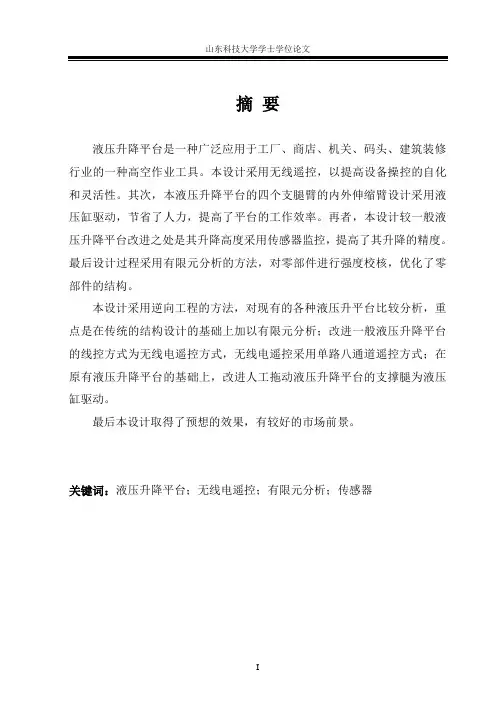
摘要液压升降平台是一种广泛应用于工厂、商店、机关、码头、建筑装修行业的一种高空作业工具。
本设计采用无线遥控,以提高设备操控的自化和灵活性。
其次,本液压升降平台的四个支腿臂的内外伸缩臂设计采用液压缸驱动,节省了人力,提高了平台的工作效率。
再者,本设计较一般液压升降平台改进之处是其升降高度采用传感器监控,提高了其升降的精度。
最后设计过程采用有限元分析的方法,对零部件进行强度校核,优化了零部件的结构。
本设计采用逆向工程的方法,对现有的各种液压升平台比较分析,重点是在传统的结构设计的基础上加以有限元分析;改进一般液压升降平台的线控方式为无线电遥控方式,无线电遥控采用单路八通道遥控方式;在原有液压升降平台的基础上,改进人工拖动液压升降平台的支撑腿为液压缸驱动。
最后本设计取得了预想的效果,有较好的市场前景。
关键词:液压升降平台;无线电遥控;有限元分析;传感器AbstractA hydraulic lifting platform is a tool for high-altitude operations that is widely used in factories, shops and offices, terminals, building decoration industry .The design of a wireless remote control is to enhance the self-control equipment and flexibility.Finally, designing process use finite element analysis, to check the strength of parts and components, and to optimize the structure of the parts.Secondly, the four outrigger arm of the hydraulic lifting platform use the design of the internal and external telescopic boom driven by hydraulic cylinders, saving human resources, improving the efficiency of the platform. Furthermore, the improvement of the design of the hydraulic lifting platform is that sensors monitor is used to accurate the height of platform and improve the accuracy of their movements.This design uses the method of reverse engineering and comparing with the various existing hydraulic platform or , focusing on the traditional design of the structure on the basis finite element analysis, the general improvement of the hydraulic lifting platform for radio-controlled wire way. A radio-controlled remote control one-way four-lane way in the original hydraulic lifting platform on the basis of improving the artificial drag hydraulic lifting platform for the support legs hydraulic cylinder drive.The design has achieved the desired effect,has a bright market prospects Keywords: hydraulic lifting platform; radio control ;finite element analysis; sensors monitor目录摘要 (I)Abstract (II)1 绪论 (1)1.1液压升降平台在机械工业中的应用及相关技术概况 (1)1.1.1 传感技术 (2)1.1.2 遥控技术 (2)1.1.3 有限元分析技术 (3)1.1.4 液压传动技术 (4)1.1.5 液压升降平台在机械行业中的应用 (5)1.2 本课题研究的目的及意义 (6)2 液压系统的方案设计 (7)3 液压系统的参数计算及选型设计 (12)3.1 电动机的选择 (12)3.2 液压泵的设计 (13)3.2.1 齿轮泵的参数计算 (13)3.2.2 齿轮泵的选型设计 (14)3.2.3 齿轮泵使用说明和常见故障 (15)3.3液压缸的设计 (16)3.4 液压元件的选择 (19)3.4.1 液控单向阀的选用 (19)3.4.2 手动换向阀的选用 (20)3.4.3 平衡阀的选用 (22)3.4.4 电磁换向阀的选用 (23)3.4.5 溢流阀的选用 (26)3.4.6 滤油器的选用 (28)3.4.7管路的选用 (30)3.4.8 油箱的选用 (33)4 液压升降平台遥控系统的设计 (35)5 遥控液压升降平台结构设计 (38)5.1遥控液压升降平台内外绞板的设计 (38)5.2 遥控液压升降平台底盘的设计 (43)6 液压升降平台的C语言编程受力分析 (47)7 遥控液压升降平台的有限元分析 (52)参考文献 (57)致谢 (58)附录 (59)1 绪论液压升降平台是一种广泛用于工厂、商店、机关及建筑装修行业,物流产业及机械加工产业的作业工具。

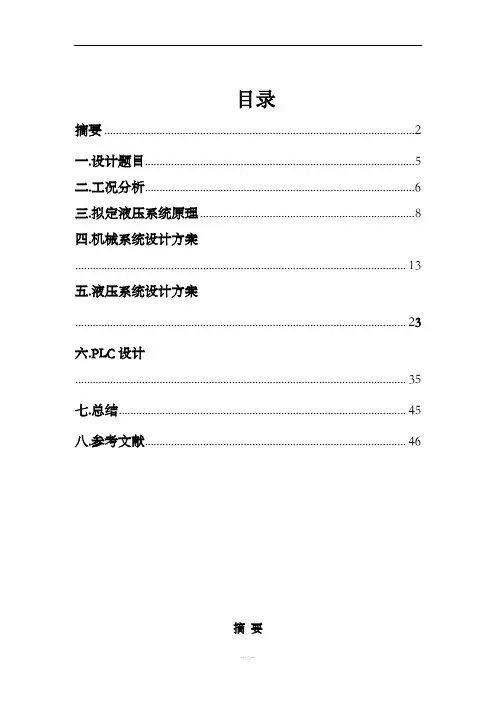
目录摘要 (2)一.设计题目 (5)二.工况分析 (6)三.拟定液压系统原理 (8)四.机械系统设计方案 (13)五.液压系统设计方案 (23)六.PLC设计 (35)七.总结 (45)八.参考文献 (46)摘要液压传动相对于机械传动来说,是一门发展较晚的技术。
自18世纪末英国制成世界上第一台水压机算起,液压传动技术只有二三百年的历史。
直到20世纪30年代它才较普遍地用于起重机、机床及工程机械。
在第二次世界大战期间,由于战争需要,出现了由响应迅速、精度高的液压控制机构所装备的各种军事武器。
第二次世界大战结束后,战后液压技术迅速转向民用工业,液压技术不断应用于各种自动机及自动生产线,从而使它在机械制造、工程机械、农业机械、汽车制造等行业得到推广应用。
机电专业课程设计环节是为了学生能够更好地巩固和实践所学专业知识而设置的,在本次课程设计中,我们以机电传动控制以及液压与气压传动中所学知识为基础,设计了压块机液压及控制系统。
本系统的液压系统主要由液压缸,换向阀,溢流阀,压力继电器,插装阀及各类泵组成,能实现颗粒散料的压制加工。
PLC控制部分主要由定时器,继电器及行程开关组成,对整个液压系统的起控制作用论文介绍了应用PLC技术对升降平台液压系统进行控制的设计方法和实现过程。
采用PLC控制,提高了该机器的可靠性,降低了人力成本,提高了企业的经济效益。
由于该行业在生产过程中,要求提高生产自动化。
若完全采用液压控制,这种控制方式电子线路复杂、继电器使用数量多,造成电气控制部分可靠性差、故障率高,日常维护量大。
随着可编程控制器(PLC)技术的发展,把PLC 控制技术应用于装药机液压装置的控制中,取代原有的液压装置控制线路。
简化了电器控制电路,提高了可靠性,取得了很好的使用效果。
并且易于修改控制程序,提高了控制系统的可扩展性。
关键字:升降平台,液压控制,可编程控制器,可靠性。
AbstractRelative to the hydraulic mechanical transmission, it is a late development of the technology. Since the 18th century the British made the world's first counting hydraulic press, hydraulic drive technology is only two or three hundred years of history. 30 years until the 20th century it was more commonly used in cranes, machine tools and construction machinery. During World War II, the War, emerged from the rapid response and high precision hydraulic control agencies of various military weapons and equipment. After World War II, after the war quickly to civilian industrial hydraulic technology, hydraulic technology continues to apply all kinds of automatic machines and automatic production lines, making it the machinery, engineering machinery, agricultural machinery, automotive manufacturing and other industries promote the use of .60 years since the 20th century, with the hydraulic technology of atomic energy, space technology, computer technology and rapid development and penetration into various industrial fields. Hydraulic technology has begun to high-speed, high-pressure, high power, high efficiency, low noise, durable, highly integrated direction. At the same time, new hydraulic components and hydraulic systems computer-aided design (CAD), computer-aided test (CAT), computer direct control (CDC), mechanical and electrical integration technologies, reliability, technology, and also the current hydraulic drive and control technology development and research direction.This paper describes the application of PLC technology to charge hydraulic system to control the design and implementation process.With PLC control and improve the reliability of the machine, reducing labor costs and improve the economic efficiency ofenterprises.As the industry in a high risk of the production process, for greater automation.If the total hydraulic control, this control complex electronic circuits, relays quantity, resulting in poor reliability of electrical control failure rate, large amount of routine maintenance.With the programmable logic controller (PLC) technology, the PLC control technology in charge of hydraulic control device to replace the hydraulic control circuit devices.Simplifies the electrical control circuit, improved reliability, made good use of effects.And easy to change control procedures and improve the control system scalability.Key words:Charge Machine,Hydraulic control,PLC,Reliability.一.设计题目设计一液压顶升工作台及控制系统,该液压缸采用竖直放置,工进速度为0.2m/min,最大采用PLC控制,使其可以顺利完成工作状态及任意位置停止,整个顶升工作台可实现手动和自动的转换,并利用PLC完成顶升动作的自动循环,其动作为电机启动——>顶升装置快速上行——>行程开关——>顶升装置慢速上行——>行程开关——>顶升装置停留——>定时器20秒——>装/卸载重物——>压力传感器——>顶升装置慢速下降——>限位开关——>停止需要考虑以下特殊工况:1 顶到极限位置时,保持系统压力防止顶升物下滑;2 工作中,突遇断电情况,保持系统压力防止顶升物下滑;3 在任意位置需要停机时,保持系统压力防止顶升物下滑;4 故障自动停机,将顶升物锁在当前位置。
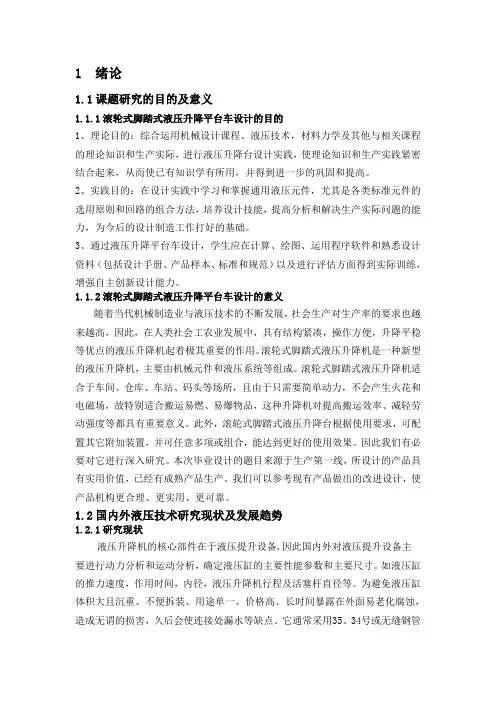
1 绪论1.1课题研究的目的及意义1.1.1滚轮式脚踏式液压升降平台车设计的目的1、理论目的:综合运用机械设计课程、液压技术,材料力学及其他与相关课程的理论知识和生产实际,进行液压升降台设计实践,使理论知识和生产实践紧密结合起来,从而使已有知识学有所用,并得到进一步的巩固和提高。
2、实践目的:在设计实践中学习和掌握通用液压元件,尤其是各类标准元件的选用原则和回路的组合方法,培养设计技能,提高分析和解决生产实际问题的能力,为今后的设计制造工作打好的基础。
3、通过液压升降平台车设计,学生应在计算、绘图、运用程序软件和熟悉设计资料(包括设计手册、产品样本、标准和规范)以及进行评估方面得到实际训练,增强自主创新设计能力。
1.1.2滚轮式脚踏式液压升降平台车设计的意义随着当代机械制造业与液压技术的不断发展,社会生产对生产率的要求也越来越高,因此,在人类社会工农业发展中,具有结构紧凑,操作方便,升降平稳等优点的液压升降机起着极其重要的作用。
滚轮式脚踏式液压升降机是一种新型的液压升降机,主要由机械元件和液压系统等组成。
滚轮式脚踏式液压升降机适合于车间、仓库、车站、码头等场所,且由于只需要简单动力,不会产生火花和电磁场,故特别适合搬运易燃、易爆物品,这种升降机对提高搬运效率、减轻劳动强度等都具有重要意义。
此外,滚轮式脚踏式液压升降台根据使用要求,可配置其它附加装置,并可任意多项或组合,能达到更好的使用效果。
因此我们有必要对它进行深入研究。
本次毕业设计的题目来源于生产第一线,所设计的产品具有实用价值,已经有成熟产品生产。
我们可以参考现有产品做出的改进设计,使产品机构更合理、更实用、更可靠。
1.2国内外液压技术研究现状及发展趋势1.2.1研究现状液压升降机的核心部件在于液压提升设备,因此国内外对液压提升设备主要进行动力分析和运动分析,确定液压缸的主要性能参数和主要尺寸。
如液压缸的推力速度,作用时间,内径,液压升降机行程及活塞杆直径等。
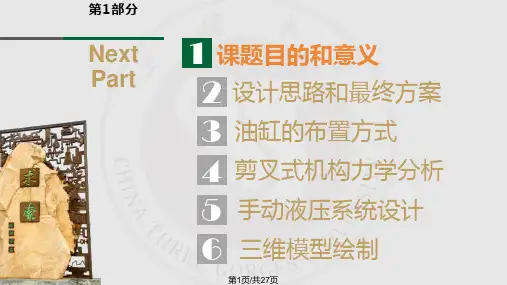
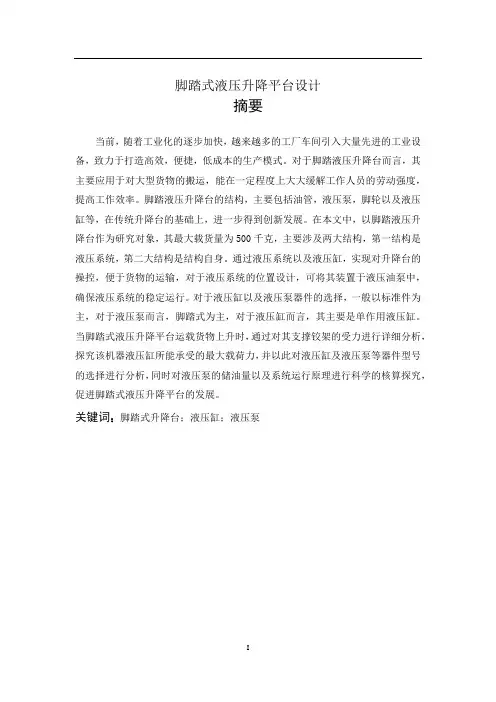
脚踏式液压升降平台设计摘要当前,随着工业化的逐步加快,越来越多的工厂车间引入大量先进的工业设备,致力于打造高效,便捷,低成本的生产模式。
对于脚踏液压升降台而言,其主要应用于对大型货物的搬运,能在一定程度上大大缓解工作人员的劳动强度,提高工作效率。
脚踏液压升降台的结构,主要包括油管,液压泵,脚轮以及液压缸等,在传统升降台的基础上,进一步得到创新发展。
在本文中,以脚踏液压升降台作为研究对象,其最大载货量为500千克,主要涉及两大结构,第一结构是液压系统,第二大结构是结构自身。
通过液压系统以及液压缸,实现对升降台的操控,便于货物的运输,对于液压系统的位置设计,可将其装置于液压油泵中,确保液压系统的稳定运行。
对于液压缸以及液压泵器件的选择,一般以标准件为主,对于液压泵而言,脚踏式为主,对于液压缸而言,其主要是单作用液压缸。
当脚踏式液压升降平台运载货物上升时,通过对其支撑铰架的受力进行详细分析,探究该机器液压缸所能承受的最大载荷力,并以此对液压缸及液压泵等器件型号的选择进行分析,同时对液压泵的储油量以及系统运行原理进行科学的核算探究,促进脚踏式液压升降平台的发展。
关键词:脚踏式升降台;液压缸;液压泵AbstractAt present, with the gradual acceleration of industrialization, more and more factories and workshops introduce a large number of advanced industrial equipment, and are committed to creating an efficient, convenient, and low-cost production mode. For the pedal hydraulic lifting platform, it is mainly used for the handling of large goods, which can greatly relieve the labor intensity of the staff to a certain extent and improve the work efficiency. The structure of the pedal hydraulic lifting platform, which mainly includes oil pipes, hydraulic pumps, casters and hydraulic cylinders, is further innovative and developed on the basis of the traditional lifting platform. In this article, the pedal hydraulic lifting platform is used as the research object, and its maximum cargo capacity is 500 kg. It mainly involves two major structures.The first structure is the hydraulic system, and the second structure is the structure itself. Through the hydraulic system and hydraulic cylinder, the control of the lifting platform is realized, which is convenient for the transportation of goods. For the position design of the hydraulic system, it can be installed in the hydraulic oil pump to ensure the stable operation of the hydraulic system. For the selection of hydraulic cylinders and hydraulic pump components, standard parts are generally the main ones. For hydraulic pumps, the pedal type is the main one. For hydraulic cylinders, it is mainly a single-acting hydraulic cylinder. When the foot-operated hydraulic lifting platform carries goods up, through detailed analysis of the force of its supporting hinge, the maximum load force that the hydraulic cylinder of the machine can bear is explored, and the hydraulic cylinders and hydraulic pumps and other device models The selection of the hydraulic pump is analyzed, and the oil storage capacity of the hydraulic pump and the operating principle of the system are scientifically calculated and explored to promote the development of the pedal hydraulic lifting platform.Key words:foot lift table; hydraulic cylinder; hydraulic pump目录1绪论................................................................................................................. ...1 1.1研究背景. (1)1.2国内外液压技术研究现状及发展趋势 (1)1.2.1研究现状 (1)1.2.2发展趋势 (2)1.3本课题研究内容 (5)2脚踏式液压升降平台车的总机设计 (5)2.1总体方案的分析比较和确定 (5)2.2液压升降平台车的结构及运动原理 (6)2.3升降台尺寸初步分析计 (7)2.3.1升降台高度的计算 (7)2.3.2相关角度的计算 (8)2.3.3液压缸作用结构图分析 (9)3升降台受力及力矩分析 (10)3.1整体受力分析图 (10)3.2外饺架受力分析图 (11)3.3内饺架受力分析图 (11)3.4力和力矩的分析计算 (12)3.4.1饺架上端饺支受力 (12)3.4.2整体受力分析计算 (12)3.4.3内、外饺架单独受力分析 (13)3.4.4力矩平衡分析 (13)3.5液压缸受力分析 (14)3.5.1液压缸受力公式的导出 (14)3.5.2液压缸最大受力时数值及角度计算 (14)4液压系统的分析 (16)4.1受载分析 (16)4.2液压系统方案设计 (16)4.2.1设计要求 (16)4.2.2液压系统原理图 (16)4.3液压缸、液压泵的选型 (17)4.3.1液压缸基本尺寸计算 (17)4.3.2液压泵设计计算及选型 (18)4.3.3油量的校核 (19)5脚轮滚轮的选用 (20)5.1选用要求 (20)5.2脚轮实际选型 (20)5.3滚轮的选用 (21)6各构件参数设与应力计算 (21)6.1内、外饺架材料及设计尺寸选择 (21)6.2滚道材料及设计尺寸选择 (21)6.3升降工作台材料及设计尺寸选择 (22)6.4底座材料及设计尺寸选择 (22)6.5应力计算及强度校核 (22)6.5.1内、外饺架力的分解 (22)6.5.2外饺架轴力图、剪力图和弯矩图分析 (23)6.5.3内饺架轴力图、剪力图和弯矩图分析 (25)6.5.4饺架应力强度校核 (26)6.5.5肋板连接轴强度校核 (29)7脚踏式升降平台重量与成本核算 (30)7.1升降台总重计算核对 (30)7.2升降台成本核算 (31)7.2.1成本核算概念 (31)7.2.2产品生产成本项目 (32)7.2.3生产成本的核算 (32)7.2.4总计生产成本 (34)8总结............................................................................................................... 34参考文献. (35)致谢................................................................................................................. . (36)1绪论1.1研究背景随着科技技术的不断发展,机器制造业迎来了新的发展高潮,人们对机器制造业提出了更高要求。
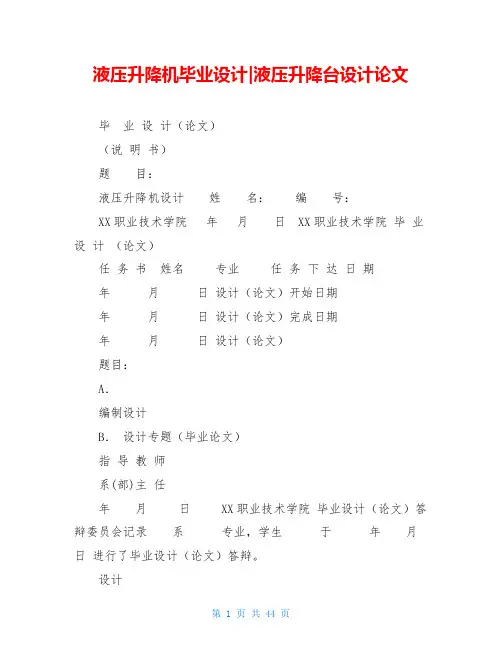
液压升降机毕业设计|液压升降台设计论文毕业设计(论文)(说明书)题目:液压升降机设计姓名:编号:XX职业技术学院年月日 XX职业技术学院毕业设计(论文)任务书姓名专业任务下达日期年月日设计(论文)开始日期年月日设计(论文)完成日期年月日设计(论文)题目:A.编制设计B.设计专题(毕业论文)指导教师系(部)主任年月日 XX职业技术学院毕业设计(论文)答辩委员会记录系专业,学生于年月日进行了毕业设计(论文)答辩。
设计题目:专题(论文)题目:指导老师:答辩委员会根据学生提交的毕业设计(论文)材料,根据学生答辩情况,经答辩委员会讨论评定,给予学生毕业设计(论文)成绩为。
答辩委员会人,出席人答辩委员会主任(签字):答辩委员会副主任(签字):答辩委员会委员:,,,,,, XX职业技术学院毕业设计(论文)评语第页共页学生姓名:专业年级毕业设计(论文)题目:评阅人:指导教师:(签字)年月日成绩:系(科)主任:(签字)年月日毕业设计(论文)及答辩评语:液压升降机设计摘要本次设计的题目是液压升降机的设计,它主要包括:主机械机构的设计,液压系统的设计,控制部分的设计三个部分内容。
在本设计中将液压系统的设计做为主要内容进行设计。
液压系统的设计又主要包括了动力源,控制元,执行元,辅助元的设计。
液压升降机主要是通过液压油的压力传动从而实现升降的功能,它的剪叉机械结构,使升降机有较高的稳定性,宽大的作业平台和较高的承载能力,使高空作业范围更大,并适合多人同时作业,它使高空作业效率更高,安全更可靠。
液压升降机广泛适用于汽车、集装箱、模具制造,木材加工,化工灌装等各类工业企业及生产流水线,满足不同作业高度的升降需求,同时可配装各类台面形式(如滚珠、滚筒、转盘、转向、倾翻、伸缩),配合各种控制方式(分动、联动、防爆),具有升降平稳准确、频繁启动、载重量大等特点,有效解决工业企业中各类升降作业难点,使生产作业轻松自如。
关键字:升降机,液压系统,液压元目录摘要....................................................... ..............1第一章升降机的发展情况 (4)1.1升降机在生产和生活中的作用和意义 (4)1.2升降机国内外的研究发展情况 (5)1.2.1国内发展情况 (5)1.2.2世界升降机发展状况和发展趋向....................................5 第二章升降机的工艺参数和工况分析 (6)2.1 升降机的工艺参数 (6)2.2升降机工况分析 (6)第三章升降机机械机构的设计和计算 (7)3.1 升降机机械结构形式和运动机理 (7)3.1.1 机械结构型式 (7)3.1.2 升降机的运动机理....................................................... (8)3.2 升降机的机械结构和零设计 (9)3.2.1 升降机结构参数的选择和确定 (9)3.2.2 升降机支架和下底板结构的确定 (14)第四章液压系统的设计要求 (14)第五章液压系统方案的选用 (14)5.1油路循环方式的分析和选择 (15)5.2开式系统油路组合方式的分析选择 (16)5.3调速方案的选择 (16)5.4液压系统原理图的确定 (16)第六章液压元的选用....................................................... .206.1 油泵和电机选择....................................................... ......20 6.1.1泵的额定流量和额定压力 (20)6.1.2 电机功率的确定....................................................... ....216.1.3 联轴器的选用.............................................................................................21 6.2 控制阀的选用....................................................... .........24 6.2.1 压力控制阀....................................................... (24)6.2.2 流量控制阀....................................................... (25)6.2.3 方向控制阀....................................................... .. (25)6.3 管路,过滤器,其他辅助元的选择计算 (26)6.3.1 管路....................................................... (26)6.3.2 过滤器的选择....................................................... (27)6.3.3 辅的选择....................................................... (28)6.4 液压元的连接....................................................... ......28 6.4.1 液压装置的总体布置....................................................... .286.4.2液压元的连接....................................................... ......29 6.5 油箱及附....................................................... ..30 6.5.1 油箱的容积....................................................... .........30 6.5.2 按使用情况确定油箱容积. (30)6.5.3 按系统发热和散热计算确定油箱容量 (3)1第七章液压缸的选用 (34)7.1 缸筒....................................................... . (34)7.1.1 缸筒与缸盖的连接形式 (3)47.1.2 强度计算....................................................... . (35)7.1.3缸筒材料及加工要求....................................................... ..367.1.4 缸盖材料及加工要求....................................................... .377.2活塞和活塞杆....................................................... (37)7.2.1 活塞和活塞杆的结构形式 (37)7.2.2 活塞、活塞杆材料及加工要求 (38)7.3活塞杆导向套....................................................... .......39 7.4 进出油口尺寸的确定....................................................... 39 7.5 密封结构的设计选择....................................................... 39 第八章液压泵站的选用.................................................33 8.1 液压泵站的组成及分类.. (33)8.2 液压泵站的选用....................................................... .....33 第九章液压系统性能验算...............................................40 参考文献....................................................... . (43)致谢....................................................... (44)第1章升降机的发展情况1.1 升降机在生产和生活中的作用和意义液压升降机不论是在工业生产还是我们的日常生活中都有着重要的作用。


升降平台毕业论文..第一篇:升降平台毕业论文..绪论1 绪论目前,升降平台广泛用于汽车、集装箱、模具制造,木材加工,化工灌装等各类工业企业及生产流水线,满足不同作业高度的升降需求,同时可配装各类台面形式(如滚珠、滚筒、转盘、转向、倾翻、伸缩),配合各种控制方式(分动、联动、防爆),具有升降平稳准确、频繁启动、载重量大等特点,有效解决工业企业中各类升降作业难点,使生产作业轻松自如。
如今的主要几种升降机构:按照升降平台构的不同分:剪叉式升降平台、升缩式升降平台、套筒式升降平台、升缩臂式升降平台、折臂式升降平台。
按移动的方法不同分:固定式升降平台、拖拉式升降平台、自行式升降平台、车载式升降平台、可驾驶式升降平台。
其中液压升降台,采用液压技术,升降平稳、噪音低。
垂直丝杠升降台采用丝杠传动方式,实现双层台面的升降,根据需要可多块组成升降台群,能在行程范围内组成不同的台阶,满足会议和演出的需要,是舞台上搭设亭、台、楼的理想道具。
水平丝杠升降台,该结构的升降台具有土建量小、所需基坑浅、行程大,运行平稳,噪音低定位准确、造价低等优点,采用水平丝杠传动,通过剪叉结构实线台面的升降运动,在行程范围内可任意停止。
链条式升降台具有良好的导向机构,保证设备运行时无倾斜。
齿轮齿条式升降台,传动精确,造价高。
螺旋器升降台具有普通升降台的全部功能,主要特点是设备占用基坑小,行程大。
设备高度仅200~500mm,行程可达14m。
当舞台建在2层以上的建筑物时,因空间受到限制时尤为适合。
本次设计的升降台是采用液压的驱动方式,它结构坚固,升降平稳,操作简单,维护方便等特点。
适用于仓库、机场、车站、工厂等需要搬运、装卸和高空作业的场所。
本设计的优点是:(1)利用国内外先进技术和成功经验,结合剪叉式液压升降台的具体使用要求,用最少的液压元件来实现单叉式液压升降台应具备的各种动作(如:起动、上升、下降、快降、停止等)。
1 装配升降定位系统工作状况分析(2)设计采用两片剪叉式机构,升降平稳,升降行程放大作用突出,结构简单可靠。
目录1、压力机液压系统设计要求 (4)2、压力机液压系统工况分析 (5)2.1液压缸工作过程运动分析 (5)2.2液压缸工作过程负载分析 (6)3、液压缸的设计 (10)3.1初选液压缸的工作压力 (10)3.2计算液压缸的尺寸 (10)3.3计算液压缸的有效面积 (10)3.4液压缸各工作阶段的压力、流量、功率计算 (11)3.5液压缸的壁厚和外径的计算 (12)4、液压缸缸盖厚度的确定 (13)5、液压缸缸盖螺栓计算和选择 (13)6、液压系统图的拟定 (14)6.1供油方式的拟定 (14)6.2调速回路的选择 (14)6.3速度连接回路的选择 (14)6.4保压回路的选择 (14)6.5泄压换向方法的选择 (15)6.6平衡及锁紧回路的选择 (16)6.7系统的工作过程分析 (16)7、确定液压泵的型号及电动机的型号 (17)7.1泵工作压力的确定 (17)7.2泵的流量确定 (18)7.3选择液压泵的规格 (18)7.4电动机的选定 (18)8、阀类元件及附件的选择 (19)9、确定管道尺寸 (19)10、液压油箱容积的确定 (20)11、液压油的选择 (20)12、液压系统性能的验算 (20)12.1 压力损失的验算 (20)12.2 油液温升的计算 (22)12.3 散热量的计算 (23)结论 (25)参考文献 (26)液压机是一种用静压来加工金属、塑料、橡胶、粉末制品的机械,在许多工业部门得到了广泛的应用。
液压传动系统的设计在现代机械的设计工作中占有重要的地位。
液体传动是以液体为工作介质进行能量传递和控制的一种传动系统。
本文利用液压传动的基本原理,拟定出合理的液压传动系统图,再经过必要的计算来确定液压系统的参数,然后按照这些参数来选用液压元件的规格。
确保其实现快速下行、慢速加压、保压、快速回程、停止的工作循环。
关键词:液压机、课程设计、液压传动系统设计Hydraulic machine is a kind of static pressure to the processing of metal, plastic, rubber, the powder product of machinery, in many industrial department a wide range of applications. The design of the hydraulic drive system in modern mechanical design work occupies an important position. Transmission fluid is the liquid medium for the work carried out energy transfer and control of a transmission system.This paper using hydraulic transmission to the basic principle of drawing up a reasonable hydraulic system map ,and then after necessary calculation to determine the liquid pressure system parameters , Then according to the parameters to choose hydraulic components specification. To ensure the realization of the fast down, slow pressure, pressure maintaining, rapid return, stop work cycle.Key words: hydraulic machine, course design, hydraulic transmission system design.1压力机的功能液压机是一种利用液体静压力来加工金属、塑料、橡胶、木材、粉末等制品的机械。
错误!未指定书签。
专业错误!未指定书签。
作者姓名指导教师定稿日期:2020年05月29日XXX机械工程系毕业设计(论文)任务书注:此表发给学生后由指导教师填写,学生按此表要求开展毕业设计(论文)工作。
XXX机械工程系毕业设计(论文)成绩表摘要本次设计的题目是全液压升降机的设计,它主要包括三个部分的内容:主机的设计,液压系统的设计,控制部分的设计。
在本设计中将液压系统的设计做为主要的内容进行设计,主机的设计根据升降台工作时的主要工作部件进行大概的估算。
液压系统的设计又主要包括了动力源,控制元件,执行元件,辅助元件的设计。
控制部分的设计为附加部分,主要设计控制电路图。
关键字:升降机液压系统执行元件ABSTRACTThis design topic is the entire plunger elevator design, it mainly includes three partial contents: Host computer design, hydraulic system design, control section design. Makes in this design the hydraulic system design for the main content carries on the design, time the host computer design basis shengjiangtai work main working part carries on the general estimate. The hydraulic system design has mainly included the power supply, checks the part, the functional element, auxiliary part design. The control section design for supplements the part, mainly designs the check circuit diagram.Keywords: Elevator hydraulic system functional element目录摘要 (3)ABSTRACT (4)第 1 章绪论 (7)第 2 章液压升降机的设计 (9)2.1升降机为全液压系统,相关工艺参数为: (9)2.2工况分析 (9)2.3升降机机械结构形式和运动机理 (9)2.4升降机的机械结构和零件设计 (10)2.5升降机系统的设计 (22)2.6执行元件速度和载荷 (23)2.7速度和载荷计算 (23)第 3 章液压系统方案的拟定 (27)3.1系统压力的初步确定 (27)3.2液压执行元件的主要参数 (27)3.3油路循环方式的分析和选择 (32)3.4开式系统油路组合方式的分析选择 (33)3.5调速方案的选择 (33)3.6液压系统原理图的确定 (34)3.7油泵和电机选择 (34)3.8控制阀的选用 (38)3.9管路,过滤器,其他辅助元件的选择计算 (40)3.10液压元件的连接 (42)第 4 章油箱及液压缸的设计 (44)4.1油箱的容积 (44)4.2缸筒 (46)4.3活塞和活塞杆 (50)4.4活塞杆导向套 (51)4.5排气装置 (52)4.6进出油口尺寸的确定 (52)4.7密封结构的设计选择 (53)4.8性能验算 (53)总结 (55)致谢 (56)参考文献 (57)第 1 章绪论这次毕业是学校为我们每个工科学生安排的一次实践性的总结,使就业前的一次大练兵,是对每个学生三年来所学知识的总体检测,使我们为进入工厂工作做好了准备。